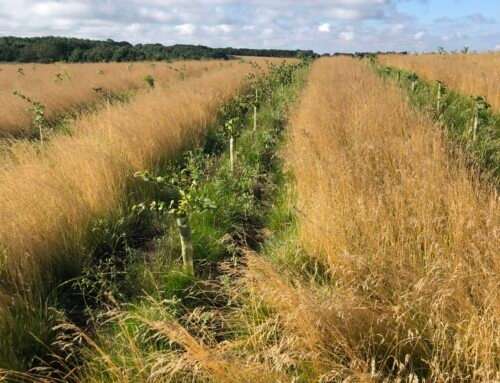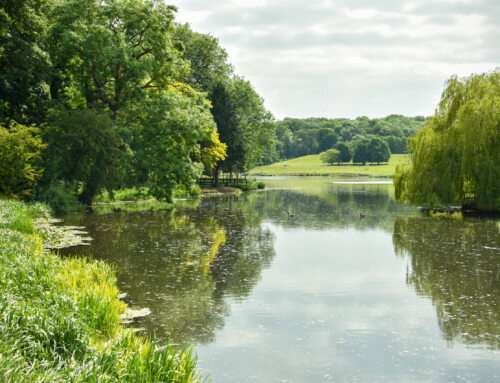Enhancing Biodiversity Through the Use of Management Plans
Site: Bardon 3
Client: Woodfarm Holdings Ltd
Departments Involved: Ecology, Arboriculture, Landscape Architecture
Overview
The development plan for a parcel of land in Ellistown, Coalville, Leicestershire involved two areas totalling 35.48 hectares, divided into 32.6 hectares for the main site and 2.88 hectares for a proposed farm.
The main site aimed to outline permission for employment buildings and a community woodland area. The proposal included additional infrastructure such as access routes, parking and drainage. Challenges comprised of ensuring that ponds, protected bat habitats, planting schemes and tree preservation orders were managed and relocated accordingly. The collaboration of our teams led to a comprehensive gain in biodiversity achieving a remarkable 21.88% net gain in habitat units and a 13.44% net gain in hedgerow units through the creation of diverse and ecologically valuable habitats. Plans for soil management and tree protection are in place for future development to emphasise sustainable practices. This development showed the potential to become accredited by the Building with Nature scheme.

Highlights
- The use of biodiversity net gain calculations to increase and showcase positive impacts.
- The creation of new woodland and wet woodlands within both areas of the site.
- Completion of mitigation and management plans for soil quality, arboriculture and biodiversity.
- Retention of ponds and the creation of additional standing water.
- Potential for Building with Nature accreditation.

Context
Before planning, the site comprised of areas of low-value grassland, hedgerows, parcels of woodland, scattered trees, standing water and buildings.
Objectives for the main site involved outlining permission for the erection of specific buildings for employment purposes with a maximum floor area of 89,000 square metres to the north, with the remainder of the site proposed as a community woodland area. As a result, the proposal included an additional access route which would incorporate parking, landscaping, drainage, highways and other associated infrastructure. Therefore, the plans for the proposal sought to reconfigure the existing structures on the site, Earthworks, and divert the public footpath known as Grange Walk.
The proposed farmstead aimed to comprise two new two-storey dwellings for farm managers with associated farm buildings including cattle sheds, bullpens, calf pens, a grain store and a steel-framed workshop. In terms of enhancement, the scheme sought to create additional planting and the inclusion of a balancing pond towards the southeast corner incorporating the existing public right of way.
Challenges
The initial surveys completed by our ecology and arboriculture teams highlighted the need for further investigations and mitigation measures to aid the acceptance of the proposal. Part of the design process required the removal of several ponds across the site except for the pond designated as a Local Wildlife Site.
The nature of the designation and suitable habitat for great crested newts (GCN) meant further surveys were required following our ecology teams’ initial assessment to determine GCN presence before the removal of the ponds. The proposal sought to develop existing buildings, though a known population of brown long-eared bats were present, with swallows and house sparrows found inhabiting the surrounding buildings. This was mitigated through the creation of optimal replacement habitats and further nesting sites.
Our arboriculture team initially identified areas of trees that required further protection alongside the existing protection order situated on the north-western boundary meaning further mitigation measures were required. Additionally, a soil management plan was requisite for planning permission, coupled with the implementation of a National Forest planting scheme given the site’s location within the National and Charnwood Forest.


Nicholsons Involvement
The Nicholsons ecology team worked to create a thorough biodiversity management plan to comply with the requirements of the local planning authority. Recommendations were provided regarding the creation, restoration, retention and enhancement of the site in addition to developmental mitigation measures. Liaising with the landscape and design team, areas of enhancement and planting measures were undertaken to accurately increase the level of biodiversity within the site.
Following this, the ecologists undertook a Biodiversity Net Gain Assessment (BNGA) to calculate the percentage of net gain the development would achieve post-completion. A bespoke bat plan was created to ensure optimal replacement habitat for the bats occupying the building set to be developed upon, with further nests created to compensate for the loss of the swallow and house sparrow nests.
Our arboriculture team conducted various tree surveys to identify trees of particular importance, followed by a detailed method statement and tree protection plan.
Additionally, our soil team undertook soil surveys within the area to aid with the planting design, as well as creating a meticulously devised soil management plan to establish healthy, sustainable soil that positively influences plant growth whilst avoiding contamination.

Outcomes
The collaboration between our ecology and landscape and design team played a pivotal role in significantly enhancing the overall biodiversity net gain within the site. The final design demonstrated an impressive 21.88% net gain in area habitat units and a substantial 13.44% net gain in hedgerow units, which surpassed the mandated level of 10%. The consequential biodiversity management plan outlined a comprehensive strategy for creating diverse and ecologically valuable habitats on-site. These encompassed wet woodland, native species-rich grassland, native scrub, replacement ponds in addition to the retained pond, additional species-rich hedgerows and hibernacula in the form of log piles.
The method statement created by our arboriculture team identified specific trees requiring extra protection, contributing to meticulous plans that effectively prevented accidental damage during the design implementation. Notably, large areas of new woodland were successfully integrated into the proposal, featuring the planting of native species across both parcels of the site. The soil quality surveys conducted by our soil team provided invaluable insights for informed planting decisions and facilitated the development of a detailed planting list tailored to the specific soil characteristics.
In an ongoing commitment to ensure sustainable soil quality, comprehensive soil management plans were instituted, focusing on safe transportation practices and minimising the potential risk of contamination.






